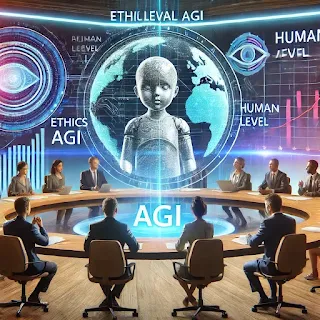AGI in 2025: Is Artificial General Intelligence Reaching Human-Level Intelligence?
Introduction:
For decades, scientists and engineers have dreamed of creating Artificial General Intelligence (AGI)—a machine that can think, learn, and reason like a human. Some experts believe that by 2025, we could be closer than ever to achieving this goal.
At a recent AI summit, a leading researcher claimed that AI is already developing basic reasoning abilities similar to human intelligence. This raises an important question—will AGI soon surpass human intelligence, or is it still just a distant dream?
In this article, we’ll analyze the progress of AGI, its potential breakthroughs in 2025, and the challenges that remain.؟
1. What Is AGI? How Is It Different from Current AI?
Today's AI systems, like ChatGPT or Google's Gemini, are examples of narrow AI—they are powerful but confined to specific tasks. AGI, on the other hand, would possess:
✅ General reasoning – The ability to solve problems across different fields.
✅ Self-learning capabilities – It can improve itself without human intervention.
✅ Adaptability – Unlike current AI, AGI can understand and react to new situations like humans.
The transition from narrow AI to AGI is challenging, but recent advancements suggest we may be closer than ever.
2. How Close Are We to AGI in 2025?
While full AGI is still under development, 2025 may mark a major step toward achieving it. Here’s why:
Breakthroughs Driving AGI Development
- Self-improving AI models – AI systems are now learning without constant human input.
- Advanced neural networks – More powerful architectures are mimicking human-like thinking.
- AI-powered robotics – Machines are developing reasoning abilities beyond basic automation.
Some experts believe we could see proto-AGI—AI with limited but general reasoning—by 2025, but full AGI may still be a decade away.
3. Challenges Preventing AGI’s Arrival
Despite rapid progress, several key challenges remain:
🔸 Computational Power – AGI requires immense processing capability, beyond current AI models.
🔸 Common Sense Understanding – Machines still struggle with human-like reasoning.
🔸 Ethical Concerns – The risk of uncontrolled AGI raises questions about safety and governance.
Without overcoming these obstacles, AGI’s full potential may remain out of reach.
4. What Happens If AGI Arrives?
If AGI reaches human-level intelligence, it could revolutionize every industry:
🌍 Workforce Transformation – Many jobs could be automated, leading to economic shifts.
⚖ Ethical & Legal Issues – Governments will need regulations to prevent misuse.
🤖 Superintelligence Potential – AGI could eventually surpass human intelligence, raising new challenges.
Some experts warn that AGI could outpace human control, while others believe it will be the greatest invention in history.
5. The Future of AGI: What Comes Next?
Will 2025 be the year AGI reaches human intelligence? While it’s unlikely that fully capable AGI will emerge so soon, we are rapidly progressing toward it. Researchers expect AGI-like features to appear in AI systems within the next few years.
Key Takeaways:
✔ AGI aims to match human intelligence but is still in development.
✔ 2025 may bring major advancements, but full AGI remains uncertain.
✔ Challenges like reasoning, computing power, and ethics need to be addressed.
✔ If AGI arrives, it will transform society in unpredictable ways.
Conclusion
AGI has the potential to change the world, but its arrival is still a work in progress. As AI systems become more advanced, the line between narrow AI and AGI will continue to blur. The question is not just when AGI will emerge—but whether we are truly ready for it.













0 Comments